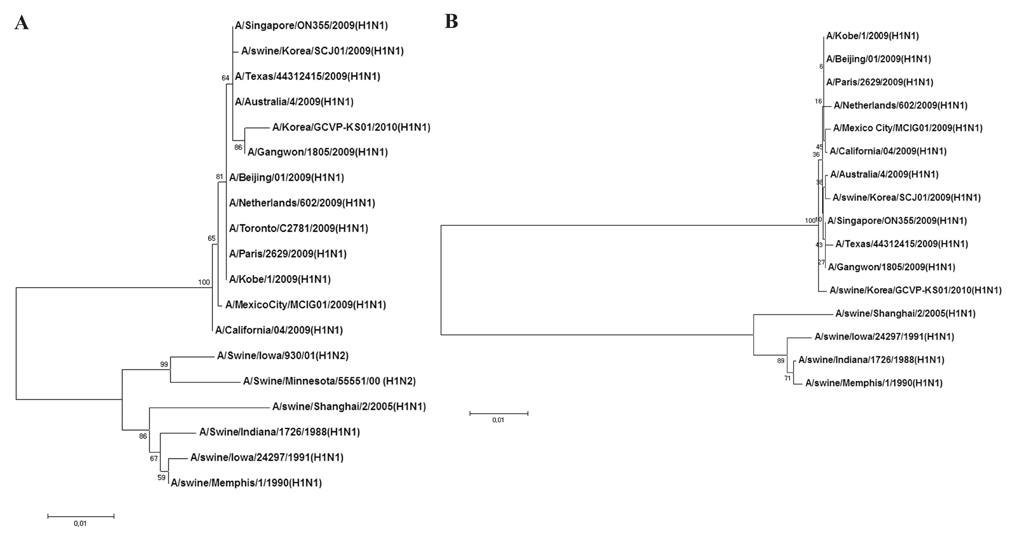Immune Netw.
2016 Oct;16(5):311-315. 10.4110/in.2016.16.5.311.
Genetic Characteristics and Immunogenicity of Pandemic H1N1 Influenza Virus Isolate from Pig in Korea
- Affiliations
-
- 1Research Unit, Green Cross Veterinary Products, Yongin 17066, Korea. suyun@gcvp.co.kr
- 2Department of Pharmacy, College of Pharmacy, Korea University, Sejong 30019, Korea. sds1@korea.ac.kr
- 3MEDIAN Diagnostics Inc., Chuncheon 24339, Korea.
- 4Department of Veterinary Medicine Virology Lab, College of Veterinary Medicine, and School of Agricultural Biotechnology, BK21 Program for Veterinary Science, Seoul National University, Seoul 08826, Korea.
- KMID: 2355025
- DOI: http://doi.org/10.4110/in.2016.16.5.311
Abstract
- A pandemic influenza A (H1N1) virus strain was isolated from a pig farm in Korea in December 2009. The strain was propagated in and isolated from both the Madin-Darby canine kidney cell line and embryonated eggs. The partial and complete sequences of the strain were identical to those of A/California/04/2009, with >99% sequence similarity in the HA, NA, M, NS, NP, PA, PB1, and PB2 genes. The isolated strain was inactivated and used to prepare a swine influenza vaccine. This trial vaccine, containing the new isolate that has high sequence similarity with the pandemic influenza A (H1N1) virus, resulted in seroconversion in Guinea pigs and piglets. This strain could therefore be a potential vaccine candidate for swine influenza control in commercial farms.
MeSH Terms
Figure
Reference
-
1. Howden KJ, Brockhoff EJ, Caya FD, McLeod LJ, Lavoie M, Ing JD, Bystrom JM, Alexandersen S, Pasick JM, Berhane Y, Morrison ME, Keenliside JM, Laurendeau S, Rohonczy EB. An investigation into human pandemic influenza virus (H1N1) 2009 on an Alberta swine farm. Can Vet J. 2009; 50:1153–1161.2. Pasma T, Joseph T. Pandemic (H1N1) 2009 infection in swine herds, Manitoba, Canada. Emerg Infect Dis. 2010; 16:706–708.
Article3. Song MS, Lee JH, Pascua PN, Baek YH, Kwon HI, Park KJ, Choi HW, Shin YK, Song JY, Kim CJ, Choi YK. Evidence of human-to-swine transmission of the pandemic (H1N1) 2009 influenza virus in South Korea. J Clin Microbiol. 2010; 48:3204–3211.
Article4. Kim SH, Moon OK, Lee KK, Song YK, Yeo CI, Bae CW, Yoon H, Lee OS, Lee JH, Park CK. Outbreak of pandemic influenza (H1N1) 2009 in pigs in Korea. Vet Rec. 2011; 169:155.5. Lange E, Kalthoff D, Blohm U, Teifke JP, Breithaupt A, Maresch C, Starick E, Fereidouni S, Hoffmann B, Mettenleiter TC, Beer M, Vahlenkamp TW. Pathogenesis and transmission of the novel swine-origin influenza virus A/H1N1 after experimental infection of pigs. J Gen Virol. 2009; 90:2119–2123.
Article6. Brookes SM, Irvine RM, Nunez A, Clifford D, Essen S, Brown IH, Van RK, Kuntz-Simon G, Loeffen W, Foni E, Larsen L, Matrosovich M, Bublot M, Maldonado J, Beer M, Cattoli G. Influenza A (H1N1) infection in pigs. Vet Rec. 2009; 164:760–761.
Article7. Brookes SM, Nunez A, Choudhury B, Matrosovich M, Essen SC, Clifford D, Slomka MJ, Kuntz-Simon G, Garcon F, Nash B, Hanna A, Heegaard PM, Queguiner S, Chiapponi C, Bublot M, Garcia JM, Gardner R, Foni E, Loeffen W, Larsen L, Van RK, Banks J, Irvine RM, Brown IH. Replication, pathogenesis and transmission of pandemic (H1N1) 2009 virus in non-immune pigs. PLoS One. 2010; 5:e9068.
Article8. Itoh Y, Shinya K, Kiso M, Watanabe T, Sakoda Y, Hatta M, Muramoto Y, Tamura D, Sakai-Tagawa Y, Noda T, Sakabe S, Imai M, Hatta Y, Watanabe S, Li C, Yamada S, Fujii K, Murakami S, Imai H, Kakugawa S, Ito M, Takano R, Iwatsuki-Horimoto K, Shimojima M, Horimoto T, Goto H, Takahashi K, Makino A, Ishigaki H, Nakayama M, Okamatsu M, Takahashi K, Warshauer D, Shult PA, Saito R, Suzuki H, Furuta Y, Yamashita M, Mitamura K, Nakano K, Nakamura M, Brockman-Schneider R, Mitamura H, Yamazaki M, Sugaya N, Suresh M, Ozawa M, Neumann G, Gern J, Kida H, Ogasawara K, Kawaoka Y. In vitro and in vivo characterization of new swine-origin H1N1 influenza viruses. Nature. 2009; 460:1021–1025.
Article9. Jung K, Ha Y, Chae C. Pathogenesis of swine influenza virus subtype H1N2 infection in pigs. J Comp Pathol. 2005; 132:179–184.
Article10. Vincent AL, Ma W, Lager KM, Janke BH, Richt JA. Swine influenza viruses a North American perspective. Adv Virus Res. 2008; 72:127–154.11. Richt JA, Lager KM, Janke BH, Woods RD, Webster RG, Webby RJ. Pathogenic and antigenic properties of phylogenetically distinct reassortant H3N2 swine influenza viruses cocirculating in the United States. J Clin Microbiol. 2003; 41:3198–3205.
Article12. Hoffmann E, Stech J, Guan Y, Webster RG, Perez DR. Universal primer set for the full-length amplification of all influenza A viruses. Arch Virol. 2001; 146:2275–2289.
Article13. Lee JH, Pascua PN, Decano AG, Kim SM, Park SJ, Kwon HI, Kim EH, Kim YI, Kim H, Kim SY, Song MS, Jang HK, Park BK, Choi YK. Evaluation of the zoonotic potential of a novel reassortant H1N2 swine influenza virus with gene constellation derived from multiple viral sources. Infect Genet Evol. 2015; 34:378–393.
Article
- Full Text Links
- Actions
-
Cited
- CITED
-
- Close
- Share
- Similar articles
-
- Influenza Associated Pneumonia
- The 2009 H1N1 Pandemic Influenza in Korea
- Pandemic Influenza (H1N1) and Mycobacterium tuberculosis Co-infection
- A Case of Pseudomembranous Tracheobronchitis Complicated by Coinfection of 2009 Pandemic Influenza A/H1N1 and Staphylococcus aureus
- Epidemiology, clinical manifestations, and management of pandemic novel Influenza A (H1N1)


